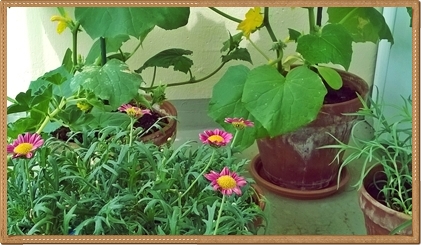 Growing Vegetables on Your Balcony!
Growing Vegetables on Your Balcony! 
Physical Settings For Growing Vegetables on Your Balcony . The Six Basic Principles you Will not Find Elsewhere For Growing Vegetables on Your Balcony! . Some More Advices For Growing Vegetables on Your Balcony! . Our Best Successes in Growing Vegetables on A Balcony! . Some Hints About Growing Flowers on Your Balcony . Our Best Successes in Terms of Flowers Grown on A Balcony!

Physical Settings For Growing Vegetables on Your Balcony
 | a mix of flowers and vegetables allows to fine sets on a balcony! |
Here are to be found all what is location for your balcony garden, tools, vegetables which may be grown, etc.
- Surface Area. Excepted whether you own a balcony of large dimensions, do not expect for large crops equivalent to those made with a real garden. Growing vegetables on your balcony is more related to the pleasure of gardening than to grow for food. Some diminutive crop on the other hand, may be mixed with some product sold at the grocery store and/or prepared at home like for example, pickles or strawberries
- What soil to use. The best choice is a mix of 2 thirds garden soil and one third compost. Using garden soil will spare you watering water as it also contains more nutrients to your vegetables. Using compost is also possible but you will use more water. When using a mix with garden soil, just change one-third of soil yearly by replacing it with compost -a process reminding how you would maintain a open air soil. After about two years, just renew with garden soil. In case of compost only, also replace one third of it yearly. A good solution when possible, is to take garden soil out from a real garden rather than buy it in garden center, as you will thus get the whole biology of a real soil, which is not the case for 'garden soil' bought in a garden center
- Aspect. The ideal is a balcony or terrace positioned to South, which will allow for balanced sunshine and heat. A balcony positioned to the West will generally face more heat as a one to the East generally be cooler. More precisely, a balcon to West is having its southern part more favourable to vegetables prefering shadow as its northern part, those prefering Sun. Try too to avoid a location facing too much wind or facing cold winds too much, like the northern winds at northern mid-latitudes. On a balcony or terrace generally, the cultivation of both vegetables and flowers is possible
- Soil Holders. The ideal are the classical terra cotta pots or windowboxes. The saucer which comes with serve to gather the possible excess of watering. Terra cotta pots are aging well as that fine aspect, which results from hard water or from fertilizers, is fashionable currently. You will have to buy a varied set -- of which varied in size -- which will be adapted to vegetables considered as you will add to that set or modify it along your gardening years. Some gardening frames are sold like adapted to balcony gardening, under the form of a wooden frame with a bottom. In that case, just buy a one with the larger height possible to have at your disposal a planting depth identical to that provided by flowerpots. A good choice at last -- as it provides for a large depth -- consists into wooden pot holders into which one can pour soil through a large plastic bag. Such a device allows to a larger depth than in a flowerpot. Current cultivation bags are contributing to that same idea. Hanging baskets may also be a alternate provided they are terra cottas and with a appropriate depth
- Tools. A small sized watering can (even without any showering end, or with a removable one) will be used for watering your plantations. A water spray may be of use but take care of not spraying on the leaves for fear of moisture and illnesses. You will also usefully purchase from a garden shop, a tool like, for example, a trowel for balcony gardening which you will use like a shovel when pouring soil or compost, or like a tool to extract withered plants. A tool that you will use like a digger as a worn knife is ideal. You will use it mostly for dig earth in your pots as that operation serves to air soil around a plant to allow it for a better breathing and for more spaced out waterings. Pruners may also be a good buy. You will have to find a location where to tidy all those tools. Think about cleaning tools after use and clean them more accurately once a year, by the end of the season. Don't forget at last your balcony's cleanliness: as in a garden a rake and shovel with some container, are in use, a dustpan and brush you use also for your home, with some miscellaneous bag are a great help on a balcony, to clean it once your installing or maintenance work over!
 | A trowel may usefully be used like a showel for balcony gardening use! |
- What Vegetables can You Grow on Your Balcony? One says that all vegetables which may be grown in a garden may be grown on a balcony. Both the easier vegetables to cultivate are radishes and cherry-tomatoes. You will, generally, have to be realistic. In terms of what are called 'root vegetables,' for example, the product of which is the root, precisely like turnips, carrots, or leeks, etc., it seems obvious that, on a balcony, with a average-sized pot, you will at best (in case of turnips) get two of them or even have barely enough depth for two carrots or leeks! From that of course, everyone is free to try experiences they want to. Take note also, on a other hand, that two varieties of vegetables can be grown together inside a same container like radishes with salads, etc. Herbs are also a good choice to grow on your balcony, like parsley, thyme, tarragon, etc. Strawberry plants are the only fruits which may be grown, albeit some websites refer also to blackberry and raspberry ones. Some varieties of little-fruit vegetables are beginning to appear on the market, like mini-squashes, etc., and also balcony-dedicated ones, and even fruit trees. Vegetables originating from the Americas or the Tropics are enduring heat better, like tomatoes, green peppers, peppers, eggplants, or beans along with broad beans and carrots. As vegetables which originate more from Europe, for example, are more used to few shiny, and even cool or wet days like radishes, lettuces, turnips or Swiss chards, cucumbers, or melons, etc. Even as a balcony remains a space more protected than a open garden, growing vegetables on a balcony will have to take that in account. Also of note is that plants located close to the balcony's edge will be the more subject to the rain's effects, for example
Website Manager: G. Guichard, site Growing Vegetables on Your Balcony! / Cultiver des légumes en balcon, http://bagarden.6te.net. Page Editor: G. Guichard. last edited: 8/9/2017. contact us at ggwebsites@outlook.com
 Growing Vegetables on Your Balcony!
Growing Vegetables on Your Balcony! ![]()

